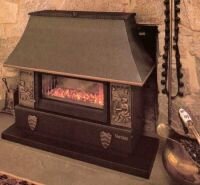Earlier this week I removed my Quad 5700 from the basement to move it upstairs. I installed it this fall and have burned about 1-1/2 cords of wood so far.
I cut the wood only this September and I know it was not ideal for use this winter. Most of it had been cut over year ago, but not cut up and split until September.
I bought a moisture meter and checked splits randomly. Most was 20%-30%. I avoided anything higher than that and some was dryer.
The single wall pipe came off the stove vertically 2', elbowed back into a tee, and rose another 2' into the bottom of an inside 25' high all-fuel chimney.
I have pulled the tee cap several times to look up the chimney, but didn't see a build up.
After taking the single-wall pipe apart, I was a little alarmed to see this:
Looking into the elbow:

Looking into the tee:

Could this be only from wood not seasoned well enough or am I doing something else wrong?
I cut the wood only this September and I know it was not ideal for use this winter. Most of it had been cut over year ago, but not cut up and split until September.
I bought a moisture meter and checked splits randomly. Most was 20%-30%. I avoided anything higher than that and some was dryer.
The single wall pipe came off the stove vertically 2', elbowed back into a tee, and rose another 2' into the bottom of an inside 25' high all-fuel chimney.
I have pulled the tee cap several times to look up the chimney, but didn't see a build up.
After taking the single-wall pipe apart, I was a little alarmed to see this:
Looking into the elbow:
Looking into the tee:
Could this be only from wood not seasoned well enough or am I doing something else wrong?


